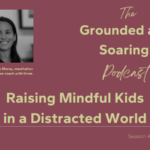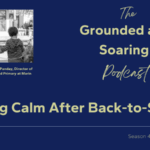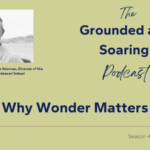Every child is an observer of nature. They possess a natural curiosity that is very similar to the scientific method – they observe, manipulate, collect data, and adjust. When their natural curiosity is not cultivated, though, they can lose interest in the scientific principles that allow them to see their world differently.

It’s not their fault, of course.
Some educational approaches trade the magic of scientific inquiry for the passive, short-lived acquisition of facts. Fortunately, it also doesn’t have to be this way.
As a veteran science teacher, my North Star is to keep my students’ learning alive. That’s why, for me, the best science projects arise naturally from an environment where purposeful work allows personal growth.
A distinct and critical principle that distinguishes the Montessori approach is that science classes are designed around the needs of the land – and for a good reason. Having a farm allows teachers to create opportunities for adolescents to study the world in a real context. In this approach, the land is the curriculum. (Ewert-Krocker, 2011).
Enter the Chickens
Last summer, the Junior High farm needed to replace an aging laying flock of chickens, so this year’s class started with a question: How do we keep 25 fragile baby chicks alive?

Following the Montessori course design, the first day of class aimed to entice and excite the students for what was to come. This is called a sensorial opener, and it connects students to a wide array of questions and inspires their motivation to seek answers.
It gives them a sense of purpose and the spark to engage deeply and fully in the upcoming work. The Guide — a Montessori term for teacher — states the problem or goal, elicits questions, and the students dive right into their work.
On our first afternoon together, it was unsurprising that students did not know the answer to “what do baby chicks need to survive?”
So we researched, shared back, and, from there, built a list of practical work tasks that we needed to complete by week’s end. This was a group effort, not a passive lecture.
They discovered that the essential requirements to keep chicks alive included the following:
- The area needed to be initially kept at 95 degrees Fahrenheit.
- The food was to be medicated.
- The water was to be in small chick-specific canisters so that they would not drown.
- The chicks required special bedding such as newspaper – and not sawdust, which they’d likely eat, fill up on, and then starve.
Safety from predators was another key component in preparing the space. In past years, predators caused significant harm to chicks. Once, every single chick just ‘vanished,’ and not a feather was found.
What I See When They’re Engaged in Work
The best classes are ones where students are running the show, doing the work, collaborating, and I’m on the sidelines.
Unlike many classroom-specific project-based lessons or units, there are real consequences and rewards on the land for their work – such as if the chicks are not fed daily or the enclosure is not locked up.
Using their senses, minds, and bodies, students know the material in a way that goes deeper than just reading about it in the abstract or seeing a chicken flock while on a field trip.
How do I know if students are engaged in their work?
I use a metric called “shiny eyes.” In many instances, this is the opposite of eyes glossing over, which is common in a presentation or lecture that runs too long.
When I see their eyes glisten, I feel most successful as a teacher because I know that I’ve helped students care.
And what happens when students care?
They learn complicated concepts deeply and in enduring ways. Key lessons that inspire and unlock student learning are given in a variety of modalities and are purposefully kept short.

What that means is that one day we might have a short lesson on cell theory and another day we might begin with an introduction to the microscope and prepared zoology slides.
The majority of the class is then spent with students exploring the concept, and this is often carried out in small groups. They each need to use the microscope, draw and label the prepared slide, and make one of their own. They later explore the 3D model of an animal cell on a genetics site.
“You are either apart from nature or a part of nature.”
David Orr, Paul Sears Distinguished Professor of Environmental Studies and Politics and Special Assistant to the President of Oberlin College
Getting Deep
When it comes to engaging students deeply, choice and autonomy are critical because they can lead to investment and ownership of the work.
An example: during the chicken class, many students became interested in and concerned with the industrial farming methods for raising egg-laying chickens after learning about them in a short film. In an examination of our food system, several students asked the question, Is modern farming of chicken eggs and meat humane?
The consensus to that question after research and writing, was no, not even close.
One argued that it would be in the interest of businesses to alter practices to better treat hens. Others called for clear regulations around egg carton labels so that consumers know where their eggs come from – small wire battery cages or cage-free outdoors, for example.
Other students simply became fascinated with birds.

When two experts brought in a live great-horned owl and a red-tailed hawk to our class, the students were entranced. They had been studying adaptations in class, so observing these birds in person allowed them to see their similarities and differences. They were shown that both birds were predators as evidenced by the location of their eyes: in the front of their skulls.
This concept was then further illustrated when skull castings were passed around that showed where the eye cavity of each bird was and the size of it relative to the skull.
Then a field trip to the California Academy of Sciences allowed for a culmination study of adaptations in the Color of Life exhibit and observation of the live penguins colony.
Because students follow their interests, they often find themselves learning from and teaching each other.
There is no better way to learn than to teach. We bring our excitement to others when we share what we know and understand. In the Montessori class, older children give lessons to younger students. In our class, ninth-year students offered a Socratic seminar on the industrial food system, taught lessons on genetics and genetic traits, and guided a hen dissection.
The point here is that choice, engagement, and autonomy led to students connecting their scientific knowledge to the world around them. Science then does not live in a book or a class; it lives where it’s always lived – in the air, water, creatures, and the inherent curiosity of humans.
The Takeaway
One of the most powerful aims of Montessori education is to prepare the adolescent for adulthood so that they understand society and how to become a part of it.
Of the three underpinnings of this aim, one is developing responsibility for both the planet and humanity. As Maria Montessori saw it, “work on the land is an introduction both to nature and to civilization and gives a limitless field for scientific and historical studies” (Montessori, CA, 68).
This is how it happens. Real work, with consequences, where each person’s contribution matters and where complex concepts are rooted in the lived experience.
Sources
David, Kahn. “Occupations as Preparation for Adult Life.” AMI Orientation to Adolescent Studies 2011, AMI NAMTA. Cleveland, Ohio. Lecture.
Ewert-Krocker, Laurie. “From Childhood to Adolescence: The Appendices.” AMI Orientation to Adolescent Studies 2011, AMI NAMTA. Cleveland, Ohio. Lecture.

Minnie McBride is one of the founding faculty members of Marin Montessori School’s Junior High. At the time, the student body was made up of just nine students. A third-generation teacher, Minnie studied environmental science at Oregon State University, earned her teaching credential from Dominican University of California, and recently completed her Master of Science in Education at Dominican as well.






Sam Shapiro
Thanks so much for this, Minnie! I appreciated so many of the insights you offer here. I was struck by the power of starting classes with questions–questions that ignite the sense of urgency in students to figure things out. I also appreciate the power of learning by doing–how teens are such “meaning-seeking” people, and so when the learning can be deepened through hands-on work and experiences, it becomes that much richer for them. Thanks again!
Carla Rummo
Thank you Minnie! My daughter has really enjoyed her chicken class, and this description helps me to understand how it is all coming together. Amazing stuff!
Doug Aley
Minnie, I love your “shiny eyes metric.” From my child’s experience, you have nailed that. So nice to have children that wake up every day thrilled to get to school. A huge piece of it is the combinatorial way in which Montessori Guides pull subjects together. No project in the real world is “just science” or “just math” or “just writing” but as an adult, you have to be able to pull these disciplines together with great executive function (project management, communication, etc.). They way every Montessori experience is set up, you are strengthening all muscles at once leading to true knowledge acquisition, vs. short term facts memorized for a test. All of that to say, thank you for this glimpse into your methodology and for doing what you do. We see the resulting excitement and curiosity every day at home!
Terrie Burns
Minnie, I love the approach to learning you’ve presented. What could be better than to raise a child that understands the systems of life and their connections to each other in the world. . We will never survive as a species until we learn that we are part of nature, along with being caretakers of it. Your students are gifted by your perspective, and, what’s more important, you are a living, breathing example of what this looks like in adult form. You are modeling what you believe. That’s the epitome of “teaching”. Thanks for sharing this informative and inspiring blog.